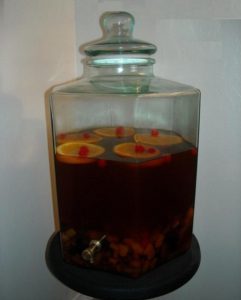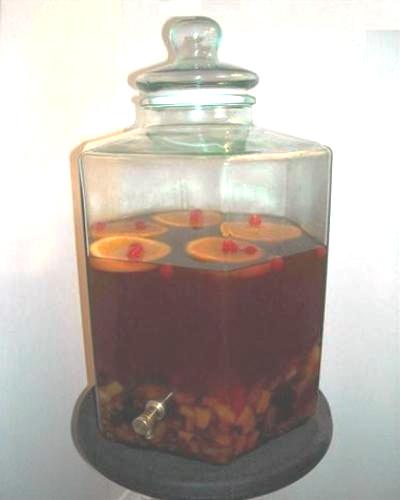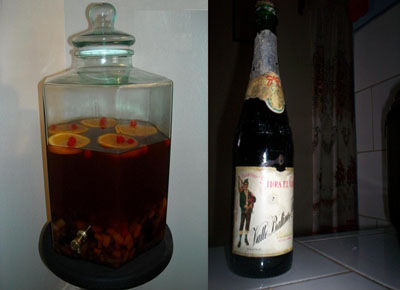 EL “ALIÑAO” ORIENTAL, UNA RECETA DE GRAN TRADICIÓN CUBANA.
EL “ALIÑAO” ORIENTAL, UNA RECETA DE GRAN TRADICIÓN CUBANA.
Típico de la zona oriental de nuestra isla, sobre todo en Granma y Holguín, ‘El Aliñao’ es un licor considerado la bebida de los nacimientos. En esta región de la isla cuando una mujer queda embarazada, junto al ajuar del futuro bebé, la familia comienza a elaborar en el hogar una bebida especial llamada ‘Aliñao’ dada la variedad de sus componentes.
Y es que el Aliñao tiene como ingredientes básicos aguardiente de caña y diferentes frutas (piñas, grosellas, higos, ciruelas y otras) que tengan la cualidad de mantenerse en buen estado por un largo período, todo aderezado con hojas de higo.
Sometido a un proceso de cocción en almíbar y posteriormente vertido en alcohol, las frutas no sólo le dan sabor al aliñao, sino que absorben el alcohol y en el proceso de añejamiento éstas quedan “borrachas” para darle peculiaridad al licor. La mezcla se deposita en un recipiente de cristal, y se sitúa en un lugar seco durante varios meses, etapa en la que poco a poco la bebida va adquiriendo un sabor característico que culmina cuando se le añaden trocitos de caña de azúcar.
Para el brindis la bebida se prepara desde los primeros meses del embarazo, y después del primer mes de vida del infante. Si el bebé es una niña, se acostumbra sellar y guardar varias botellas de aliñado para abrirlas cuando la homenajeada cumpla quince años.
Pasado el tiempo la añeja bebida se habrá convertido en un jarabe de frutas, que mezclado con más alcohol queda lista nuevamente para brindar aún más.
La verdad es que se recomienda empezar la elaboración del licor después de la confirmación del embarazo o los cuatro meses de gestación y su consumo no se realiza hasta que se haya producido el anhelado a llegada del bebé. Luego, a las personas que acudan a conocer la nueva cría, se les obsequia un trago de esta bebida como muestra de agradecimiento y cortesía, parte de las costumbres familiares en las cuales se entrelaza la tradición.
No se trata de una receta especial, ni la obligación de hacer determinada cantidad, aunque algunos textos sobre el tema difieren en la composición y confección del Aliñao, devenida delicada bebida que sirve, también, para cualquier otra celebración social.
TRADICIÓN ISLEÑA.
El Aliñao no se trata de una receta especial, ni la obligación de hacer determinada cantidad, aunque algunos textos sobre el tema difieren en la composición y su confección, devenida delicada bebida que sirve, también, para cualquier otra celebración social.
Otros documentos, sin confirmación, hablan de la antigüedad del licor que parece beberse en Cuba y también una tradición de las Islas Canarias españolas, principalmente en Tenerife.
Por ejemplo, se argumenta que anteriormente se seleccionaba una cantidad grande de ciruelas de abundante masa, luego se ponían a hervir durante 5 minutos y después de escurrirlas de un día para otro se “ahogaban” en aguardiente de caña durante 45 días.
Finalizado este tiempo se ponían a escurrir nuevamente uno o dos días más y al término de esta jornada se cocinaba un almíbar al cual se le agregaba canela y hojas de higo y se sumergían las ciruelas en ella. En la actualidad la receta original se ha ido transformando con el tiempo y de acuerdo a los gustos particulares y la localidad, pero siempre sin perderse la esencia.
Y es que en nuestro país las tradiciones, al rescate muchas de ellas, van de la mano de un legado patrimonial que atesora valores de familia, cortesía, y sobretodo cubanía.
 THE ORIENTAL “ALIÑAO”, A RECIPE OF GREAT CUBAN TRADITION.
THE ORIENTAL “ALIÑAO”, A RECIPE OF GREAT CUBAN TRADITION.
Typical of the eastern part of our island, especially in Granma and Holguín, ‘El Aliñao’ is a liquor considered the drink of births. In this region of the island when a woman becomes pregnant, along with the trousseau of the future baby, the family begins to make at home a special drink called ‘Aliñao’ given the variety of its components.
And it is that the Aliñao has as basic ingredients cane liquor and different fruits (pineapples, currants, figs, plums and others) that have the quality of keeping in good condition for a long period, all seasoned with fig leaves.
Subjected to a process of cooking in syrup and then poured into alcohol, fruits not only give flavor to the aliñao, but absorb alcohol and in the aging process they are “drunk” to give the liquor peculiarity. The mixture is deposited in a glass container, and it is placed in a dry place for several months, during which the drink slowly acquires a characteristic flavor that culminates when pieces of sugar cane are added.
For the toast the drink is prepared from the first months of pregnancy, and after the first month of life of the infant. If the baby is a girl, it is customary to seal and store several bottles of dressing to open when the honoree turns fifteen.
After a while, the old drink will have turned into a fruit syrup, which mixed with more alcohol is ready again to provide even more.
The truth is that it is recommended to start the elaboration of the liquor after the confirmation of the pregnancy or the four months of gestation and its consumption is not done until the desired one has arrived at the arrival of the baby. Then, people who come to know the new baby, are given a drink of this drink as a token of gratitude and courtesy, part of the family customs in which the tradition is intertwined.
It is not a special recipe, nor the obligation to make a certain amount, although some texts on the subject differ in the composition and preparation of the Aliñao, a delicate drink that also serves for any other social celebration.
THE ISLANDS TRADITION.
The Aliñao is not a special recipe, nor the obligation to make a certain amount, although some texts on the subject differ in the composition and its preparation, becoming a delicate drink that also serves for any other social celebration.
Other documents, without confirmation, speak of the antiquity of the liquor that seems to be drunk in Cuba and also a tradition of the Spanish Canary Islands, mainly in Tenerife.
For example, it is argued that previously a large quantity of plums of abundant mass was selected, then they were boiled for 5 minutes and after being drained from one day to the next they were “drowned” in cane liquor for 45 days.
At the end of this time they would drain again one or two more days and at the end of this day a syrup was cooked to which cinnamon and fig leaves were added and the plums were immersed in it. Currently the original recipe has been transformed over time and according to the particular tastes and the locality, but always without losing the essence.
And in our country traditions, to the rescue many of them, go hand in hand with a patrimonial legacy that treasures family values, courtesy, and above all Cuban.
Agencies/RadioCadena/Guadalupe Y. Díaz/ Internet Photos/ Arnoldo Varona/ TheCubanHistory.com
THE CUBAN HISTORY, HOLLYWOOD.








